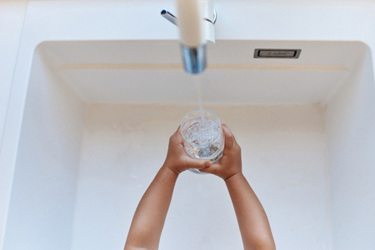From Source To Tap: Promoting Home Water Testing Year-Round
By Ellie Gabel

Water specialists do their best to ensure safe drinking water for people nationwide. Despite their diligence in monitoring and treating wastewater at municipal facilities, some households are still susceptible to contamination. Encouraging homeowners to regularly test their own water during the year will help pinpoint missed hazards and provide an additional safeguard.
Understanding Water Quality Risks
An estimated 99.2% of Americans have access to potable water, while 88.9% have access to sanitation. Yet, an alarming 489,836 households still lacked complete plumbing from 2014 to 2018. The number of individuals facing poor water quality remains high today.
The U.S. EPA says nearly 70,000 national waterbodies don’t meet federal water quality standards. Widespread exposure to per- and polyfluoroalkyl substances (PFAS) — forever chemicals — puts Americans at risk of developing various health problems. An influx of nonpoint source pollution from runoff, urbanization, population growth, climate change, and cyberattacks on wastewater systems are other common issues.
In 2022, Jackon, Mississippi, endured historic flooding that damaged its water treatment plant and left 150,000 residents without safe drinking water for several weeks. Meanwhile, 5.83% of children in Buffalo, New York, who were tested for blood lead levels (BLL) showed BLLs three times higher — a problem likely from old lead service lines.
The Limitations Of Aging Water Infrastructure
The U.S. water infrastructure faces several challenges in combating contamination and related issues, with many treatment plants failing or aging under increased operational strain. According to a 2022 EPA report, the U.S. will need $630 billion over the next 20 years to upgrade its wastewater and stormwater facilities to ensure clean drinking water for everyone.
Yet even the most advanced treatment plant can only achieve so much in distributing clean, safe water. There is always a risk of pollution after water leaves the facility and works its way to households. Older home plumbing — encased in lead, copper, and bacteria — may also introduce harmful contaminants.
While municipalities conduct frequent water testing, it doesn’t provide a broad scope of the full distribution system. Additionally, not testing the water enough could cause specialists to overlook short-term reverse flow and isolated corrosion.
Why Test For Water Quality Throughout The Year?
Although the U.S. has made significant investments in improving water quality and treatment infrastructure, it doesn’t make it infallible. Therefore, homeowners should test their water quality several times a year.
1. Seasonal Changes
The change of seasons could negatively impact water quality, from extreme temperatures to human activity and other environmental conditions. For example, dying leaves in the fall could alter the taste and smell of drinking water. Likewise, salt applied to icy roadways can enter waterbodies through overland flow during spring melt.
The added precipitation in spring also increases sedimentation and agricultural runoff in rivers, streams and lakes. Ideally, safe drinking water should have a pH between 6.5 and 8.5, but higher amounts of soil, bedrock, minerals, chemicals, and pollutants can knock it out of range.
Meanwhile, hotter weather in the summer is prime for bacterial growth. E. coli, Campylobacteria, and Giardia can be particularly dangerous to humans. Cyanobacteria — blue-green algae — is also well known for degrading drinking water during harmful algal blooms or red tides.
2. Plumbing Problems
Perhaps surprisingly, the U.S. still distributes water through 9.2 million lead service lines nationwide. Lead exposure is so dangerous that the EPA has set a maximum standard of zero contamination in drinking water, stating even low blood lead levels could be hazardous to people’s health.
Even if a home doesn’t have lead service lines, leaching from corrosion may still occur with brass and chrome-plated faucets, iron pipes, and plumbing with soldered lead. The amount of lead that enters water systems depends on water temperature, alkalinity, types of minerals present, and how much wear the pipes endure.
3. Protection for Vulnerable Populations
Those living in rural areas or underserved communities are considered “last mile” households — populations that are most difficult to reach with clean water services. These individuals face distinctive challenges like poor water quality from inefficient treatment plants, isolated contamination, and insufficient testing.
Last-mile communities can especially safeguard their health by monitoring their home’s water quality themselves and addressing problems as they arise.
4. Private Well Contamination
Homeowners with private wells are responsible for maintaining their water quality without assistance from their municipal water system. As such, they should conduct regular water testing throughout the year.
E. coli and total coliform cause gastrointestinal problems like diarrhea, nausea, and vomiting. These bacteria often derive from sewage pollution, fertilizers, decentralized wastewater systems, and fecal matter. Other contaminants to test for include arsenic, radon, and pesticides.
Protecting Home Water Quality One Test At A Time
Some matters are out of water specialists' control when it comes to water quality. Although they devote themselves to protecting their communities from harm, there will always be external risks they can't prevent. Therefore, water professionals need to encourage homeowners to test the water several times a year.
 Ellie Gabel is a writer specializing in environmental science and innovative technologies. She can be reached at ellie@revolutionized.com.
Ellie Gabel is a writer specializing in environmental science and innovative technologies. She can be reached at ellie@revolutionized.com.
